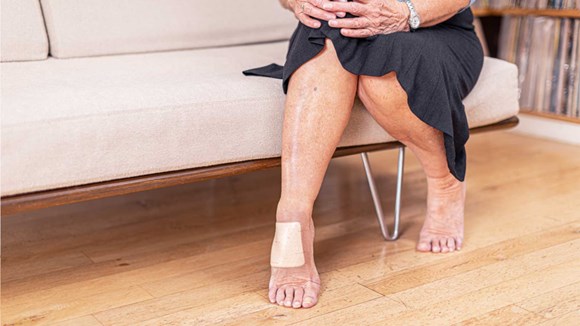How to look after your wound
This page is designed to provide information on the procedure for change of wound dressings at home. Even if you are looking after your wound at home, it is important to keep in touch with your nurse or healthcare practitioner to make sure your wound has the best chance to heal quickly.
They will give you guidance about taking care of your wound, and these resources aim to help you or your carer change your dressing safely when your nurse is not able to visit your home.
1. Prepare for your dressing change

Make sure you have a bag next to you to put your old dressing and gloves in (fasten a bag with tape to a table if possible)

On a clear, flat surface, set up an area to do the dressing change with the new dressing (still in its packet), your disposable gloves (you will need 2–3 pairs), hand sanitiser, gauze and any other items you may need.

Your nurse may advise you to clean your wound in the shower if this is practical and safe. Alternatively you can use a bowl of lukewarm tap water near your dressing change area.
2. Change the dressing

Wash your hands thoroughly with soap and water for 20 seconds, especially between fingers and palms of hands.

Important: Dry your hands with something clean.

Put on disposable gloves or use hand sanitiser.
3. Remove the old dressing

Starting from the top of the dressing, hold your skin and peel the edge of the dressing away from the skin. Do it slowly and if needed use some lukewarm water to help the removal of the dressing.

Once you remove the dressing place it together with the gloves into the bag
4. Clean the wound

Use new disposable gloves

If you are using lukewarm water, wet the gauze. Clean the surrounding skin first.

Then take a new gauze and clean the wound. Clean from inside to out. If you do the cleaning in the shower, shower the wound with lukewarm water and use a gauze, if needed, to clean the wound and surrounding skin.

When out of the shower, pat dry the surrounding skin carefully with gauze and put them into the bag. Look at the wound (does it look, smell or feel different? see tips on what to look out for below). You can also take a photograph to share with your nurse.
5. Apply the new dressing

Wash your hands and put on a new pair of gloves or use the hand sanitiser.

Remove the dressing from the packet and peel the protective cover from one half.

Place the side that had the protected cover on your wound and surrounding skin.

Remove the other protective layer from the dressing and make sure the dressing pad covers the wound.

Check that the dressing is properly sealed then apply moisturisers/emollients to the surrounding skin if needed.

Wash your hands.
How often should I change my dressing?
- Leave your dressing in place for as long as possible, or as long as your nurse recommends. Normally a dressing is changed between 1 and 3 times a week.
It will be necessary to change your dressing immediately in these situations:
- If fluid starts to leak out of the edge of the dressing
- If the dressing peels off

What to look out for?

These conditions are signs that your wound might be infected:
- It is more painful than normal
- The amount of fluid increases significantly
- The skin around your wound starts to swell and becomes red and fiery
- If the smell from your wound gets worse
- If there is excessive heat from/in your wound
Other conditions that can affect the wound healing is:
- If you see more yellow or new black tissue developing
You should immediately contact your nurse if you see signs of infection
What can help a wound to heal?
- It is important that the wound is kept moist to support healing
- Do not smoke
- Eat a healthy and balanced diet
- Exercise regularly within your own ability
- Get a good night’s sleep
Your wound may take longer to heal for a number of reasons both related to your general health and the wound condition.

What are specialised wound dressings designed to do?

- Provide physical protection for your wound
- Keep the wound moist and prevent the dressing from causing pain and damage at removal
- Stay on your wound longer to support wound healing*
- Absorb the fluid from your wound and prevent it getting onto your clothes
- Be comfortable to wear
* Depending on the condition of the wound and surrounding skin, or as indicated by clinical practice.